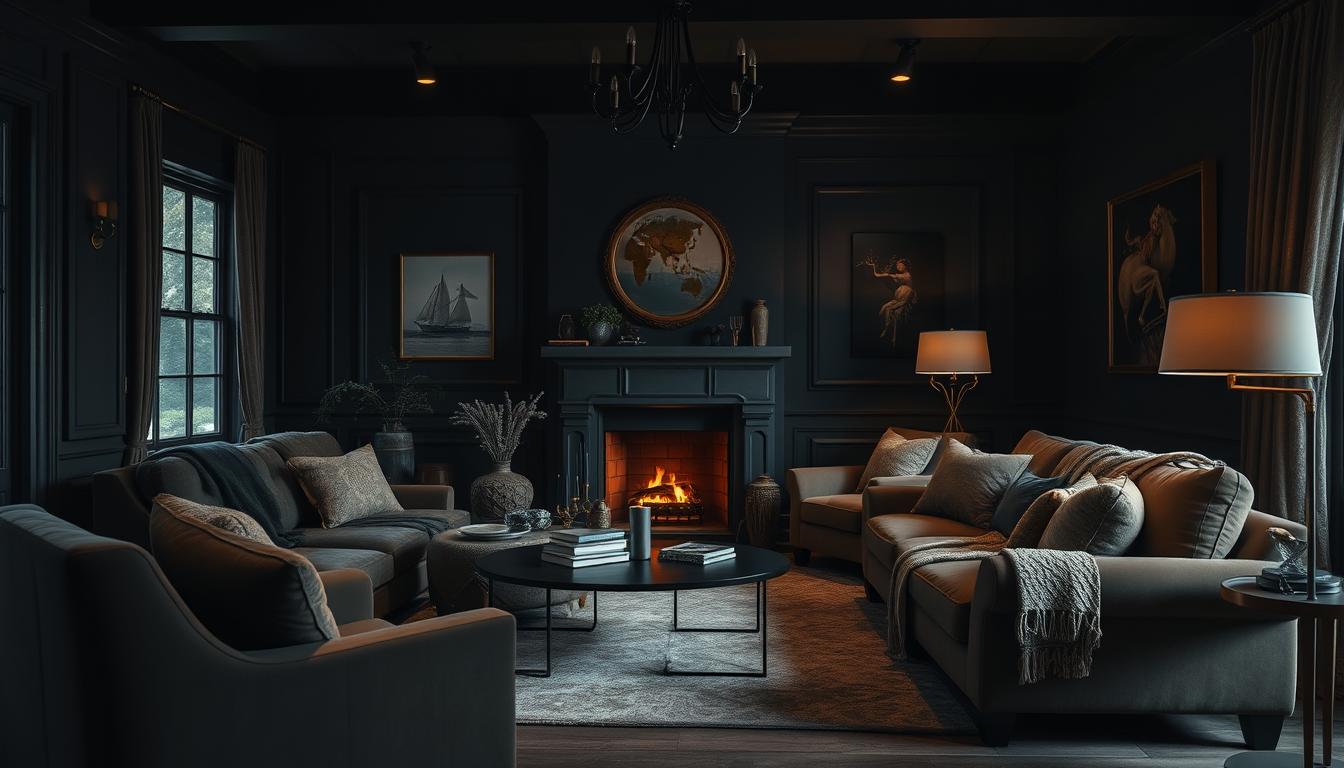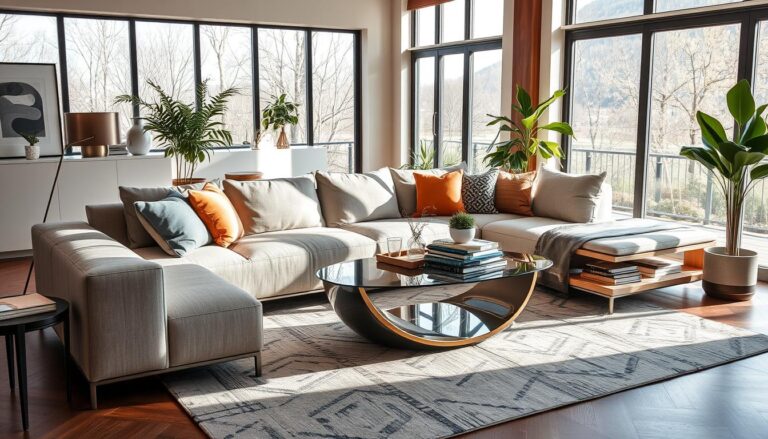3 Essentials for a Perfect Moody Living Room
Ever dreamed of a living space that feels cozy and deep? A moody living room combines lighting, color, and texture to create a cozy haven. But what makes a moody room truly special? Let’s explore the key elements that turn a room into a dramatic, cozy space.
Key Takeaways
- Lighting is crucial in setting the moody ambiance, from natural light management to strategic ambient and statement fixtures.
- Embracing dark, rich color palettes can create a cocooning, intimate atmosphere, but balance is key.
- Layering diverse textures, from plush fabrics to matte finishes, adds depth and visual interest to the space.
Understanding the Moody Living Room Aesthetic
Dark interiors have fascinated designers for centuries. From Victorian jewel-toned rooms to today’s cozy living spaces, the “moody” look has changed with time. Exploring its history and psychology helps us see why it’s so appealing.
Historical Origins of Moody Interior Design
In the 17th and 18th centuries, rich homeowners wanted intimate, elegant rooms. They used deep colors, heavy drapes, and fancy furniture. This showed off their wealth and style.
Modern Interpretations of Dark and Cozy Spaces
Today, moody rooms are different. They’re simpler, with a focus on texture and natural materials. The goal is to make a cozy, emotional space in your home.
Psychology Behind Moody Interiors
Moody rooms deeply affect our feelings. They can make us feel calm, cozy, or even luxurious. The mix of light and shadow, along with rich colors and textures, creates a unique experience.
“Moody interiors have the ability to transport us to a different state of mind, offering a respite from the bright and busy world outside.”
The love for dark, cozy spaces is growing. The history and emotional impact of moody design will keep shaping our living spaces.
Essential Color Palettes for Dark and Dramatic Spaces
Creating a moody, dramatic living room needs careful color choice. Dark color schemes and moody paint colors can make a space feel deep and sophisticated. Homeowners should pick rich hues that work well together to set the mood.
A navy blue and forest green and charcoal gray combo is popular. It brings coziness and elegance, making the room feel like a cozy cocoon. For a rustic feel, try earthy tones like warm browns, burnt oranges, and mustard yellows.
| Color Palette | Mood and Atmosphere | Complementary Accents |
|---|---|---|
| Navy, Forest Green, Charcoal Gray | Cozy, Sophisticated | Brass, Leather, Velvet |
| Warm Browns, Burnt Oranges, Mustard Yellows | Rustic, Naturalistic | Wood, Linen, Woven Textures |
Choosing the right color palette is key for a moody living room. Mix dark color schemes with lighter accents and textures. This mix adds depth and interest to the room.
Mastering Lighting in a Moody Living Room
Lighting is key to a moody living room. It’s about managing natural light and picking the right fixtures. Understanding lighting helps you get the cozy, dramatic look you want.
Natural Light Management
Managing natural light is the first step. Use draperies, blinds, or shades to control brightness. Try layering different curtains for more flexibility.
Ambient Lighting Solutions
Ambient lighting adds warmth to the room. Use recessed lights, wall sconces, and floor lamps. Dimmable lights let you adjust the mood, creating a cozy mood lighting effect. Place these lights carefully for even light and a harmonious feel.
Statement Light Fixtures
Dimmable lights can be the room’s stars. Pendant lights, chandeliers, or big floor lamps make a statement. They add depth and a warm glow. Choose unique shapes and finishes to enhance the mood.
Mastering lighting in a moody living room makes it inviting. It’s a space for relaxation and thought.
Selecting the Perfect Dark Wall Colors
Choosing the right wall color is key for a moody living room. Dark paint can make a room feel deeper and cozier. But picking the perfect dark shade is important to avoid feeling too dark.
Room size matters a lot. In small rooms, lighter shades like deep grays or navy blues work well. They prevent the room from feeling too small. But in bigger rooms, you can go for bolder colors like moody blacks or deep greens.
The room’s natural light also plays a big role. Rooms with lots of sunlight can handle darker colors. But if it’s not very bright, choose lighter shades to keep it cozy.
Choosing dark colors should match the mood you want. Dramatic blacks and grays add sophistication. Warm colors like burgundies and plums create a cozy feel. Try out different colors to see how they look with your furniture and lighting.
Texture and Material Selection for Depth
Creating a moody living room involves using texture and materials wisely. This blend adds depth and visual interest. It makes the space feel more alive, inviting guests to explore with all their senses.
Fabric Combinations
Textiles are key to adding depth to your living room. Mix soft velvet with the shine of silk curtains. Then, add rougher textures like linen or chunky knit throws for contrast.
Wall Treatments
Walls can also enhance the mood. Use textured wallpaper for depth, like a herringbone pattern or metallic design. Or, go for exposed brick or concrete for a raw, industrial look.
Furniture Finishes
Furniture finishes greatly affect the room’s mood. Choose velvet upholstery for your sofa and chairs for a cozy feel. Then, pair these with wooden or metal pieces, like a distressed coffee table or blackened steel console, for balance.
By mixing tactile surfaces, textured wallpapers, and thoughtful furniture finishes, you create a moody room. It will captivate your guests and make them feel immersed in a unique atmosphere.
Furniture Placement in Dark Spaces
Designing a moody living room requires careful furniture placement. It’s all about space planning, focal points, and room flow. This way, your dark and dramatic decor will shine.
Space planning is key. Choose furniture that fits the room well. This keeps the space open and easy to move around. Don’t overdo it to avoid a cluttered feel.
Creating focal points is vital. Place a standout piece, like a big sofa or accent chair, to catch the eye. Add matching furniture around it to boost the design.
Good room flow is essential. Arrange furniture to guide movement smoothly. This makes the room feel welcoming and easy to navigate.
To balance the dark, add lighter pieces. For instance, a dark sofa with a light accent chair can lighten the mood. This adds interest without overwhelming the space.
| Furniture Placement Considerations | Tips for Moody Living Rooms |
|---|---|
| Space Planning | Ensure proportional pieces, allow for ample walkways, and avoid overcrowding. |
| Focal Points | Strategically place a statement piece to draw the eye and create a visual anchor. |
| Room Flow | Arrange furniture to encourage natural transitions and a seamless atmosphere. |
| Balancing Dark and Light | Incorporate lighter pieces to create visual interest and prevent the room from feeling overwhelming. |

By focusing on these points, you can make a moody living room that looks great and works well. It will have a smooth flow and a nice balance of light and dark.
Incorporating Metallic and Reflective Elements
Moody living rooms look great with metallic and reflective surfaces. These add depth, glamour, and luxury. Brass, copper, and mirrors can make a dark room feel cozy and inviting.
Metal Finishes Guide
Metallic finishes make your room more interesting. Use brass for a warm, luxurious look. Copper adds a cozy glow. Stainless steel or chrome bring a modern touch.
Try mixing different metals for a unique look. This creates a dynamic and cohesive feel.
Mirror Placement Strategy
Mirrors are key in moody rooms. They reflect light, making the room seem bigger and brighter. Place mirrors near windows or light sources.
Also, use mirrored furniture like coffee tables. This adds depth and light to your space.
| Metallic Finish | Aesthetic | Recommended Use |
|---|---|---|
| Brass | Warm, luxurious | Accent pieces, hardware, lighting |
| Copper | Inviting, cozy | Decorative accessories, light fixtures |
| Stainless Steel | Sleek, modern | Furniture, hardware, appliances |
Using metallic finishes and mirrors can make your room feel more lively. It adds depth, brightness, and interest. Play with these elements to find the perfect dark and dramatic look.
Plants and Natural Elements in Moody Decor
In a moody living room, adding indoor plants and organic textures can lighten the dark feel. These elements bring in a natural energy. By following biophilic design, you can make your space both beautiful and peaceful.
Choosing the right plants for a moody room is key. Look for ones that do well in little light. ZZ plants, snake plants, and pothos are great choices. They add greenery without needing a lot of care. Placing them around the room helps balance the dark colors.

Adding organic textures like woven baskets and wooden accents also helps. These materials make the room feel warmer and cozier. They add interest and enhance the biophilic design feel.
- Embrace low-light tolerant plants like ZZ plants, snake plants, and pothos
- Incorporate organic textures through natural materials like woven baskets, jute rugs, and wooden accents
- Strategically place plants and natural elements to balance the darker tones of the moody living room
By carefully adding indoor plants and organic textures, you can make a moody living room. It will be both beautiful and full of natural life.
Balancing Light and Dark Elements
Making a moody living room is all about finding the right mix of light and dark. This balance is crucial for a cozy yet eye-catching space. By using contrast techniques and smart color distribution, you can enhance the visual balance, light accents, and tonal variation in your design.
Contrast Techniques
Contrast is the heart of a moody living room. Mix dark and light colors, matte and glossy finishes, and shapes to make it lively. Add depth with textures like velvety furniture and shiny metal accents.
Color Distribution Methods
Where you place colors greatly affects the tonal variation and visual balance of your room. Start with a dark wall color, then add lighter touches and pops of color. Use light accents like metallics or light fabrics to balance the dark and keep the room cozy.
“The key to a successful moody living room is finding the right balance between light and dark elements. It’s a delicate dance, but when done well, the result is a space that is both cozy and visually striking.”
Mastering contrast techniques and smart color distribution leads to a stunning visual balance in your moody living room. It seamlessly blends light accents and tonal variation for a cozy and captivating atmosphere.
Conclusion
We’ve explored the moody living room, focusing on color, lighting, and texture. These elements create a sophisticated and inviting space. We looked at the history of dark and cozy interiors and their modern appeal.
Mastering lighting is key to a warm and cozy living room. This includes managing natural light and using ambient and statement fixtures. Choosing the right dark wall colors and layering textures are also important.
When transforming your living room, follow moody living room tips. Use dark interior inspiration and aim for a cozy home design that shows your style. With these tips, you’ll create a space that’s both beautiful and comforting.







